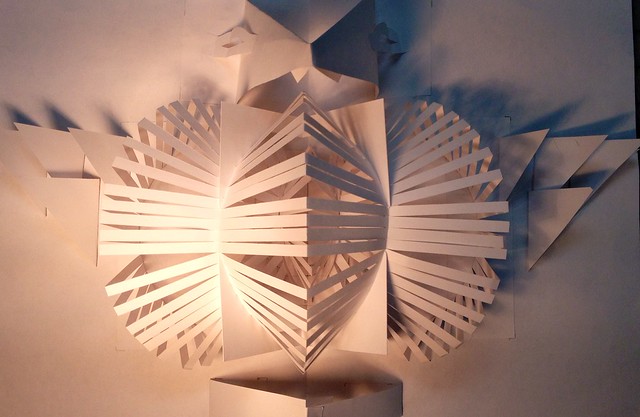
For the pop up workshop, I had everyone first mimic one of the basic pop-up engineering techniques. Next, I had them embellish a second version of that basic technique. Then I had them make things more complex by repeating the shape within the same structure. The idea is to create a repeated predictable pattern. Up until this point everything is very geometric but the next challenge would be to introduce narrative though organic shapes and organic patterns…
Links to images, templates, and lesson summaries developed by workshop participants appear at the bottom of this page.
Experimenting with Space
Through the art of paper engineering, you’ll transform a flat surface into three-dimensional form. In this workshop you’ll learn multiple strategies and techniques used in the creation of pop-ups and sculptural books. Topics covered will include qualities of paper, techniques for manipulation of paper, creating maquettes, folding and cutting. Over the course of two and half days, participants will discover the magic of pop-up and sculptural book arts, moving from beginner’s lessons through more advanced mechanisms. Following the workshop, participants will create an exemplar and a standards-based lesson to complete the course. Techniques introduced will translate well into all classroom levels, from K-12.
Course Agenda:
- Friday evening – Meet and greet, introduction to tools and basic techniques, exploration of examples of paper forms, discussion about how to introduce paper engineering into an art classroom and what techniques are developmentally appropriate for various levels of learners. We begin by mimicking basic pop up techniques. After mastering those, we will embellish upon them.
- Saturday – Hands on workshop, demonstration and guided practice using various techniques, studio time, critique and feedback. Today, we will begin to combine forms to create predictable repetitions of form; the design emphasis is upon formal qualities. The “walk away” is to develop a precision template that would allow another to recreate your design. (Template: dotted lines indicate folds and solid lines indicate cut marks.)
- Sunday – Demonstration of advanced techniques, studio time, critique and feedback, review of expectations for final assignment. Today, we will combine forms with graphics – both found and created – to develop a narrative. The “walk away” is a homework assignment to create a lesson plan summary that you might use in your own teaching of art. Your lesson concept should be developmentally appropriate to the students you teach.

Learning Goals:
- Demonstrate effective use of introductory paper-engineering media, techniques, and processes.
- Demonstrate the skillful, safe, and responsible application of appropriate media, tools, and equipment.
- Manipulate paper to create dynamic and dimensional form.
- Create visual interest through the appropriate use of artistic elements and principles.
- Create visual forms that combine visual interest with structural integrity.
- Communicate ideas about how to effectively and appropriately incorporate paper engineering into one’s own curriculum.
Assessment:
- Understanding and applying media, techniques and processes. Participants will develop and expand their knowledge of visual arts media, techniques, and processes in order to express ideas creatively in their artworks. [10%]
- Application of appropriate structures and functions. Participants will demonstrate a knowledge of the elements and principles of design and show an aesthetic awareness of the visual and tactile qualities in the environment that are found in works of art. [10%]
- Reflecting upon one’s own work and the work of others. Participants will use thorough analysis, interpretation, and judgment to make informed responses to their own artworks and those of others. [10%]
- Engages in behaviors that promote learning. Participants demonstrate proficiency and craftsmanship; actively engages in all learning activities; contributes to a positive learning environment; utilizes problem-solving strategies; works in collaboration when appropriate; and follows art room expectations and procedures. [10%]
- Final Assignment. Students will create an exemplar and write a standards-based lesson, translating learning from this workshop into a lesson appropriate for use in their own classroom. Lesson and exemplar will be submitted digitally, no later than two weeks from the conclusion of workshop. [60%]
Curriculum Connections: Missouri Grade Level Expectations for Visual Art
- Strand I: Product/Performance, 2A: Sculpture, Ceramics, and Other Medias: Select and apply three-dimensional media, techniques and processes to communicate ideas and solve challenging visual art problems, National Standards VA1, Show-Me Standards FA1
- Strand I: Product/Performance, 3A: Fine Art: Communicate ideas about subject matter and themes in artworks created for various purposes, National Standards VA1, Show-Me Standards FA1
- Strand II: Elements and Principles, 1B, 1C, and 1G: Shapes, Forms, Space: Select and use elements of art for their effect in communicating ideas through artwork, National Standards VA2, Show-Me Standards FA2
Supply List
PLEASE NOTE: Classes are held contingent on a minimum enrollment, which is determined five business days prior to the class start date. As a class may be cancelled, we recommend that you do not open or use your materials until at least two days prior to your class start date. This way, you are free to return your merchandise without problem. Students will be contacted only if a class is cancelled.
Student Supply List
- White paper and card in various weights
- Colored, textured, and glossy paper and card stocks
- White Elmer’s glue (Book binder’s glue is optional, but not necessary.)
- Mechanical pencil and straight edge ruler (I recommend a metal ruler)
- White eraser
- Your choice of mark-making media (watercolor, markers, crayons, pens, etc.)
- Your choice of collage materials (magazine pages, photos, etc.)
- X-Acto knife and several fresh blades, self-healing cutting mat
- Good quality scissors
- Compass
- Optional: Discarded book, if you are interested in exploring sculptural book arts
Learning Links
http://en.wikipedia.org/wiki/David_A._Carter
http://www.dummies.com/how-to/content/materials-for-your-paper-engineering-workshop.html
http://www.centerforbookarts.org/classes/classdetail.asp?classeventID=1168
https://www.3rdward.com/class/pop-up-card-workshop/1653
http://www.shawnsheehy.com/cv/workshops-lectures-panels/
http://www.youtube.com/watch?v=YuQsxFhBGzw&list=PL964A7CFA66761415
Workshop Participant Links
Gallery of workshop participant images (will be updated with additional images on 4/15/14)
Jeremy Baker 1 | 2 | 3 | 4 | 5
Sarah King 1 | 2 | 3 | 4 | 5 | 6 | 7 | 8 | 9
